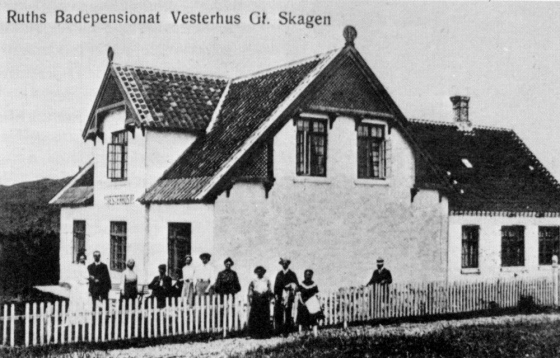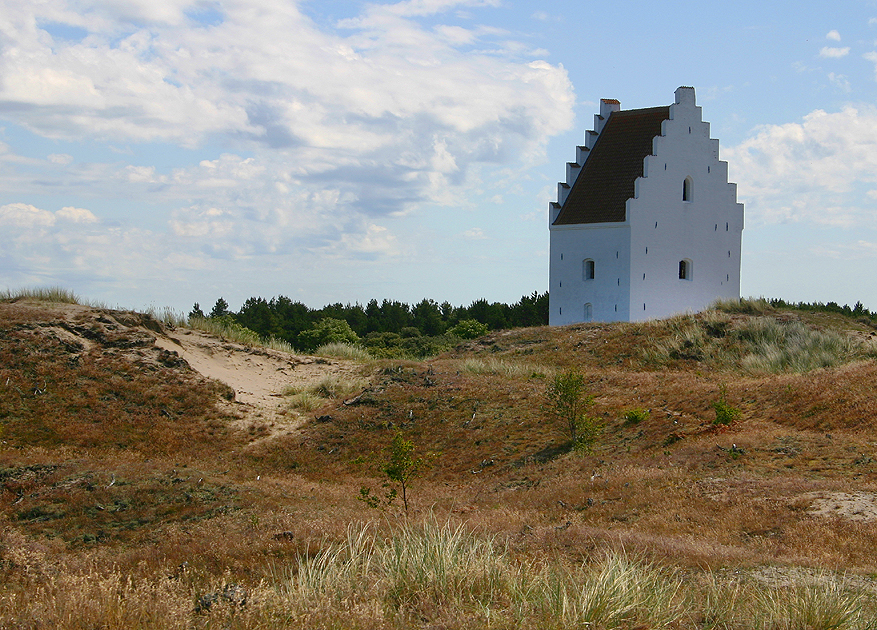|
Ruth's Hotel
Ruth's Hotel ( da, Ruths Hotel) is a historic hotel in the Højen district of Skagen in the far North of Jutland, Denmark. Named after its founders, Emma and Hans Christian Ruth, who opened it as ''Badepensionat Vesterhus'' in 1904, the establishment has now gained a reputation not only for comfort but for its French Brasserie restaurant run by Michel Michaud, said to be Skagen's best. Ruth's Hotel also contains a Gourmet Restaurant ("Ruths Gourmet") and a wellness center. History In 1891, Hans Christian Ruth built a house in Højen (also known as Old Skagen). An extension was added on the east side in 1909 with 12 rooms to be used as guest-house accommodation. A further enlargement followed in 1912 with 18 bedrooms and in 1928 an additional floor was added to house bedrooms. In an attempt to attract painters, a further extension was completed with rooms and a studio. Major alterations to the central section were completed in 1919 with a concert room, a dining room and a pantry. [...More Info...] [...Related Items...] OR: [Wikipedia] [Google] [Baidu] |
Højen
Højen or Gammel Skagen on the west side of Skagen Odde is an old fishing community which now forms part of the town of Skagen in the far north of Jutland, Denmark. History The first building in the Skagen area was built in Højen in the 12th century. It belonged to the shepherd Tronder who became the first of Skagen's fishermen. Højen was the largest community on the peninsula until about 1340 when it was overtaken by what is now Skagen's Vesterby. The first documented reference to Højen occurred in the 15th century when it was a fishing hamlet. In 1884, a beacon was installed to guide mariners to the lighthouses on the tip of Skagen Odde. In 1892, a lighthouse was established in Højen itself, functioning until 1956 when it was replaced by Skagen West Lighthouse. It was demolished in 1956. A life-boat station was opened in Gammel Skagen in 1865."Tidstavl ... [...More Info...] [...Related Items...] OR: [Wikipedia] [Google] [Baidu] |
Skagen
Skagen () is Denmark's northernmost town, on the east coast of the Skagen Odde peninsula in the far north of Jutland, part of Frederikshavn Municipality in Nordjylland, north of Frederikshavn and northeast of Aalborg. The Port of Skagen is Denmark's main fishing port and it also has a thriving tourist industry, attracting 2 million people annually. The name was applied originally to the peninsula but it now also refers to the town. The settlement began during the Middle Ages as a fishing village, renowned for its herring industry. Thanks to its seascapes, fishermen and evening light, towards the end of the 19th century it became popular with a group of impressionist artists now known as the Skagen Painters. In 1879, the Skagen Fishermen's Association was established with the purpose of facilitating the local fishing industry through the Skagensbanen railway, which opened as a narrow-gauged railway in 1890. The modern port of Skagen opened on 20 November 1907, and with ... [...More Info...] [...Related Items...] OR: [Wikipedia] [Google] [Baidu] |
Jutland
Jutland ( da, Jylland ; german: Jütland ; ang, Ēota land ), known anciently as the Cimbric or Cimbrian Peninsula ( la, Cimbricus Chersonesus; da, den Kimbriske Halvø, links=no or ; german: Kimbrische Halbinsel, links=no), is a peninsula of Northern Europe that forms the continental portion of Denmark and part of northern Germany. The names are derived from the Jutes and the Cimbri, respectively. As with the rest of Denmark, Jutland's terrain is flat, with a slightly elevated ridge down the central parts and relatively hilly terrains in the east. West Jutland is characterised by open lands, heaths, plains, and peat bogs, while East Jutland is more fertile with lakes and lush forests. Southwest Jutland is characterised by the Wadden Sea, a large unique international coastal region stretching through Denmark, Germany, and the Netherlands. Geography Jutland is a peninsula bounded by the North Sea to the west, the Skagerrak to the north, the Kattegat and Baltic Sea to the ... [...More Info...] [...Related Items...] OR: [Wikipedia] [Google] [Baidu] |
Denmark
) , song = ( en, "King Christian stood by the lofty mast") , song_type = National and royal anthem , image_map = EU-Denmark.svg , map_caption = , subdivision_type = Sovereign state , subdivision_name = Danish Realm, Kingdom of Denmark , established_title = History of Denmark#Middle ages, Consolidation , established_date = 8th century , established_title2 = Christianization , established_date2 = 965 , established_title3 = , established_date3 = 5 June 1849 , established_title4 = Faroese home rule , established_date4 = 24 March 1948 , established_title5 = European Economic Community, EEC 1973 enlargement of the European Communities, accession , established_date5 = 1 January 1973 , established_title6 = Greenlandic home rule , established_date6 = 1 May 1979 , official_languages = Danish language, Danish , languages_type = Regional languages , languages_sub = yes , languages = German language, GermanGerman is recognised as a protected minority language in t ... [...More Info...] [...Related Items...] OR: [Wikipedia] [Google] [Baidu] |
Michel Michaud
Michel Michaud (born 1946) is a French chef who brought French cuisine to Denmark in 1971. Gaining wide acclaim for gourmet cuisine in restaurants across the country, he moved to Ruth's Hotel in Skagen in 2004. Biography Born in Cognac in the French department of Charente, at the age of 15 he trained as a chef at Tarbes. He went on to work in Saintes, Cahors and at Avallon in Burgundy where he joined the Michelin-starred restaurant Hostellerie de la Poste."Michel Michaud" , Ruths Hotel. Retrieved 7 November 2013. He arrived in Denmark in 1971, where he worked for Sven and Lene Grønlykke, first in Falsled Kro on |
Olaf Dahler & Dagmar Ruth February 1912
Olaf or Olav (, , or British ; Old Norse: ''Áleifr'', ''Ólafr'', ''Óleifr'', ''Anleifr'') is a Scandinavian and German given name. It is presumably of Proto-Norse origin, reconstructed as ''*Anu-laibaz'', from ''anu'' "ancestor, grand-father" and ''laibaz'' "heirloom, descendant". Old English forms are attested as ''Ǣlāf'', ''Anlāf''. The corresponding Old Novgorod dialect form is ''Uleb''. A later English form of the name is ''Olave''. In the Norwegian language, ''Olav'' and ''Olaf'' are equally common, but Olav is traditionally used when referring to Norwegian royalty. The Swedish form is ''Olov'' or ''Olof'', and the Danish form is ''Oluf''. It was borrowed into Old Irish and Scots with the spellings ''Amlaíb'' and ''Amhlaoibh'', giving rise to modern version ''Aulay''. The name is Latinized as ''Olaus''. Notable people North Germanic ;Denmark *Olaf I of Denmark, king 1086–1095 *Olaf II of Denmark, also Olaf IV of Norway *Oluf Haraldsen (died c. 1143), Danish ... [...More Info...] [...Related Items...] OR: [Wikipedia] [Google] [Baidu] |
Brig
A brig is a type of sailing vessel defined by its rig: two masts which are both square rig, square-rigged. Brigs originated in the second half of the 18th century and were a common type of smaller merchant vessel or warship from then until the latter part of the 19th century. In commercial use, they were gradually replaced by fore-and-aft rigged vessels such as schooners, as owners sought to reduce crew costs by having rigs that could be handled by fewer men. In Royal Navy use, brigs were retained for training use when the battle fleets consisted almost entirely of iron-hulled steamships. Brigs were prominent in the coasting coal trade of British waters. 4,395 voyages to London with coal were recorded in 1795. With an average of eight or nine trips per year for one vessel, that is a fleet of over 500 colliers trading to London alone. Other ports and coastal communities were also be served by colliers trading to Britain's coal ports. In the first half of the 19th century, the va ... [...More Info...] [...Related Items...] OR: [Wikipedia] [Google] [Baidu] |
Jörgen Philip-Sörensen
Niels Jörgen Philip-Sörensen (born 23 September 1938 in Malmö, died 18 January 2010Sydsvenskan, 20 January 2010: ''Jörgen Philip-Sörensen död'' in ) was a businessman of Danish ancestry. Philip-Sörensen led the demerger of from in 1981. [...More Info...] [...Related Items...] OR: [Wikipedia] [Google] [Baidu] |
Buildings And Structures In Skagen
A building, or edifice, is an enclosed structure with a roof and walls standing more or less permanently in one place, such as a house or factory (although there's also portable buildings). Buildings come in a variety of sizes, shapes, and functions, and have been adapted throughout history for a wide number of factors, from building materials available, to weather conditions, land prices, ground conditions, specific uses, monument, prestige, and aesthetic reasons. To better understand the term ''building'' compare the list of nonbuilding structures. Buildings serve several societal needs – primarily as shelter from weather, security, living space, privacy, to store belongings, and to comfortably live and work. A building as a shelter represents a physical division of the :Human habitats, human habitat (a place of comfort and safety) and the ''outside'' (a place that at times may be harsh and harmful). Ever since the first cave paintings, buildings have also become objects or ... [...More Info...] [...Related Items...] OR: [Wikipedia] [Google] [Baidu] |



